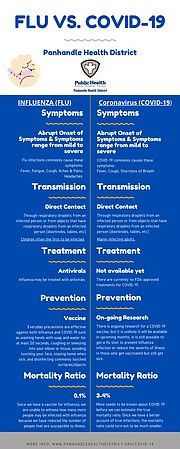Flu vs. COVID-19: Can’t compare them
This is a series about COVID-19 preparation and regional updates. Check The Press and cdapress.com daily for new information, tips, and ways our healthcare professionals are working to keep our community safe.
* * *
You may be hearing a lot on the news about how the coronavirus (COVID-19) compares to influenza (flu). This is a question we’ve been answering often, too. The short answer is that it’s not a fair comparison.
Since we have a vaccine and treatment for the flu it’s not really fair to compare it to a novel coronavirus, like COVID-19. Literally everyone is susceptible to contracting COVID-19. We can protect ourselves from the flu by getting the vaccine in late fall or early winter.
Even if you were to contract the flu, we have treatments available that would greatly reduce the chance of you becoming severely ill or dying. This brings up the point that we typically know when the flu is coming and we have protections in place prior to help keep our community safe. Flu is not a reportable disease like COVID-19, and the CDC has been able to calculate the mortality ratio for flu through many studies.
Around 80% of people who get COVID-19 will experience mild symptoms and will be expected to self-isolate at home. These 80% will not require hospitalization.
With that being said, we don’t have a vaccine or treatments for COVID-19 like we have for the flu. That’s why comparing the two creates an unfair mortality ratio making COVID-19 seem much deadlier than the flu. Lastly, without knowing the actual number of people who have had or have COVID-19, we don’t have an exact mortality ratio.
Below are some explanations to some of the common questions asked regarding the flu and COVID-19.
Transmission
•Both viruses are transmitted by direct contact through respiratory droplets or, less commonly, objects or materials which can carry the infection like hard surfaces.
•Transmission may occur 24-48 hours before symptoms appear for influenza, which is a major driver of transmission; while there are reports of transmission prior to becoming symptomatic with COVID-19, it does not appear to be the main driver on transmission.
•Children are key drivers of transmission in influenza, but not for COVID-19
•With influenza, children are generally the first in the household to become infected.
•Incubation period (time between exposure to when symptoms appear) is three days (range 1-4 days) for influenza, while it is estimated to be about five days (range 2-14 days) for COVID-19.
•Serial interval (time between symptom onset of primary case to symptom onset of secondary case) of influenza is approximately 3 days compared to 5-6 days for COVID-19.
Symptoms
•Both infections cause respiratory illness. See our graphic for specific symptoms.
Treatment
•Influenza may be treated with antivirals. There currently are no FDA-approved treatments for COVID-19.
Prevention
•There is ongoing research for a COVID-19 vaccine, but it is unlikely it will be available in upcoming months. It is still possible to get a flu shot to prevent influenza infection or reduce the severity of illness if you get the flu.
•Everyday precautions are effective against both influenza and COVID-19 such as washing hands with soap and water for at least 20 seconds, coughing or sneezing into your elbow or tissue, avoiding touching your face, staying home when sick, and disinfecting commonly touched surfaces/objects.
Mortality Ratio
Since we have a vaccine for influenza, we are unable to witness how many more people may be infected with influenza because we have reduced the amount of the population that is susceptible to illness.
Current estimates for the mortality ratio appear to be higher for COVID-19 (3-4%) compared to influenza (generally less than 0.1%). However, more needs to be known about COVID-19 before we can estimate the true mortality ratio.
These are both crude ratios (number of reported deaths / number of reported cases) and many factors can affect both the numerator and the denominator. Various factors could affect the denominator, such as the recent changes to testing criteria or fear of isolation/stigma if tested positive. If all true infections were known, the denominator would be larger, and we would see a smaller mortality ratio.
Influenza is currently more widespread in communities throughout the world, making it difficult to compare because of many of the factors discussed here.
While COVID-19 is making waves worldwide, in most cases it is manageable at home — much like the flu. You can find the information from this article as well as the latest updates and ways to protect yourself at cdc.gov/covid19.



